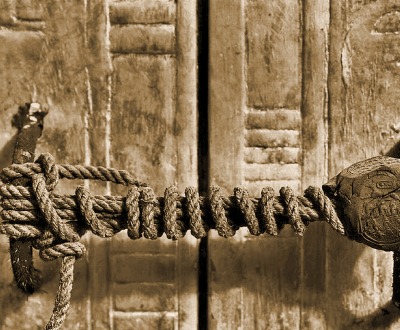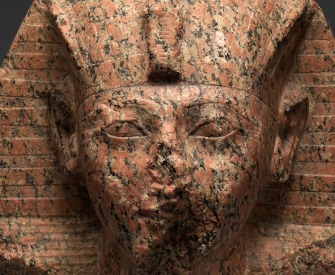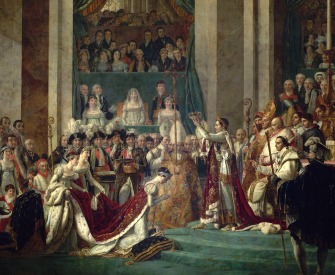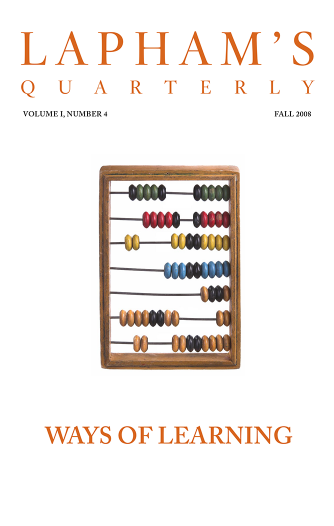Nature has planted in our minds an insatiable desire to seek the truth.
—Marcus Tullius Cicero, 45 BC
Unbroken seal on Tutankhamun’s tomb, Valley of the Kings, Egypt, 1922. © Private Collection / Prismatic Pictures / Bridgeman Images.
When you discover gold or an ocean, you know what you’re looking at and that you have found something worth having or knowing. The same is not true when ancient texts are discovered, for the process of interpretation, and ultimately realizing what something is and is worth, can take a long time. In the “realms of gold,” of books written in the distant past, discovery lies in figuring out the translation. This is a dangerous subject, for books written in dead languages are far from dead. Ancient religious texts have enormous power. Even the most obscure sacred texts and images are involved in the brutalities of geopolitics. Verses written over a thousand years ago underlie territorial claims, the treatment and rights of women, the uses of water, and other key issues that define the lives of millions. The interpretation, and misinterpretation, of religious writing and iconography from the past is the cause of much of the violence in the world. At Bamiyan, where the Taliban dynamited fourth- and fifth-century statues of the Buddha, and Palmyra, where ISIS has destroyed ancient temples, religious relics are the target of violence as well. To destroy sacred artifacts and books is to destroy a culture. Sometimes a more subtle process of destruction can occur, as when the misunderstanding of another culture misrepresents what is written in the original.

Vanitas Still Life, by Edwaert Collier, 1662. The Metropolitan Museum of Art, Purchase, 1871.
Ten years ago I undertook to translate the earliest extensive religious text, the original version of the Pyramid Texts in the Pyramid of Unis. This complex body of minute hieroglyphic writing, deliberately sealed away over four thousand years ago, was brought to light when European archaeologists opened the small Old Kingdom pyramids at Saqqâra in the winter of 1880. Great minds over the ages, among them Plato and Newton, believed that hidden within the pyramids was a treasured body of knowledge, long sought for the scientific and philosophical insight it contained. Yet the actual discovery of the Pyramid Texts made barely a cultural ripple in the world. In the intellectual climate of imperial Europe, the newly created academic discipline of Egyptology dismissed the hieroglyphic text as a disconnected collection of magic spells about snakes mixed into an incoherent myth involving the dead pharaoh with various animals and gods. The translations made no sense at all, and it is obvious that the original had not been understood. The problem of interpretation did not end in the nineteenth century.
Even the most recent scholarly translation of the Pyramid Texts, published in 2005, points to a parochial interpretive tradition:
Pull back, Baboon’s penis! Open, sky’s door! You sealed door, open a path for Unis on the blast of heat where the gods scoop water. Horus’ glide path—TWICE—will Unis glide on...and they will make a path for Unis that Unis may pass on it: Unis is Horus. Back, gored longhorn with the horizon’s fingers on his horns! Fall down, crawl away! Unis is a screeching, howling baboon, Unis’ anus on Unis’ back and Unis’ back-ridge on Unis’ head. Unis will make ululation and sit among the youngsters.
This rendering of a primary religious text from another part of the world as a set of nonsensical magic spells with a screeching baboon and, elsewhere in the text, a “Cannibal Hymn” places this tradition squarely in the intellectual conventions of nineteenth-century colonial Europe. The original is contaminated with the exotica tropes that characterize the writing of adventure novelist H. Rider Haggard.
As I looked at the spare and elegant hieroglyphic writing on the pyramid walls, the question arose: Would writing of this complexity and length be executed with such care in order to say something so meaningless? I realized that the meaning of the Pyramid Texts was still undiscovered; the text had been buried for a century by academic incomprehension, as it was for millennia by desert sand.
French linguist Jean-François Champollion is credited with discovering the meaning of hieroglyphs by establishing a list of hieroglyphic signs and their Greek equivalents based on his studies of the Rosetta Stone. He shared his results in a series of papers published starting in 1821, and his work has been continued by generations of scholars. How then can a major hieroglyphic text remain misunderstood? The question goes to the heart of the origin of written language itself.
Meticulous inch-high engravings of grasses and flowers, egrets, spoonbills, the wattled crane, the griffin vulture, the whale-headed stork—the vocabulary of hieroglyphic writing is uniquely drawn from an aesthetic delight in nature. The pictures that form hieroglyphic words represent not only the living thing itself but metaphorical dimensions that convey the essence of the living animal: a picture of the curlew with its scimitar beak in the sand defines the verb to find, the flamingo is the hieroglyph for red, the letter f in the hieroglyphic alphabet is the deadly horned viper that makes the spitting fff sound as it strikes. The origins of written language in the forms of nature show the evolution of thought from the tactile experience of the physical world. Hieroglyphs are a clear and detailed portrait of the timeless and the observable, and as such they have a stunning range of meaning and a startling immediacy.
Alan Gardiner, the author of Egyptian Grammar, wrote in 1927, “It must never be forgotten that in the eyes of the old Egyptians, the hieroglyphic writing always remained a system of pictorial representation as well as a script.” Yet the pictorial nature of hieroglyphs, with its range of universally accessible meaning and aesthetics, was sidelined by early twentieth-century scholars like Gardiner who attempted to define the language as a grammatical system along the lines of the model developed for Greek (a language that postdates it by two thousand years). One feels Gardiner’s frustration, for this grammatical model could never provide an accurate rendering of hieroglyphic writing of any complexity, since in hieroglyphs, unlike in Greek, the vowels that designate nouns, verbs, and verb forms are not written down. Gardiner sees this as the mark of an inferior rather than an ingenious written language:
The Egyptian scribes ignored the vowels in writing…A like neglect of the vowels is seen in Phoenician, Hebrew, and Arabic…The reason for the Egyptian omission of the vowels is not far to seek. It is the characteristic of the family of languages to which Egyptian belongs that one and the same word presents different vocalizations according to the forms that it assumes and the contexts in which it appears…Such a variability of the vowels could not fail to engender the feeling that the consonants were all that mattered.
Thus Gardiner suggests that the translator, having become familiar with the basic meaning of the hieroglyphic vocabulary and with the sentence structure, simply guess at what is there, writing that “it often devolves upon the translator to supply the implicit logical nexus between sentences, as also between words.” He writes in another context that the need to fill in gaps means “the only basis we can have for preferring one rendering to another, when once the exigencies of grammar and dictionary have been satisfied—and these leave a large margin for divergencies—is an intuitive appreciation of the thread of the ancient writer’s mind. A very precarious basis, all will admit.”
The academic translation of the Pyramid Texts quoted earlier translates the same simple hieroglyphic word sbn, which is repeated three times in the first four columns of the surviving text, three different ways. It is rendered as a noun with an adjective (glide path) in the first instance, as a future verb (will glide) in the second, and as an imperative verb with a different meaning (crawl away!) in the third. That the result of this method of translation is unreadable and meaningless is evident in Gardiner’s own conclusion. He writes that, “despite the reputation for philosophic wisdom attributed to the Egyptians by the Greeks, no people has ever shown itself more averse from speculation.” Gardiner goes on to note that “until the beginning of the nineteenth century, the opinion persisted almost as an article of faith that the Egyptian hieroglyphs gave symbolic expression to recondite philosophical and religious doctrines.” This interpretation, he insists, was “erroneous.” But the error lies not in approaching this language, and what is obviously a key sacred text from the past, with diligent probing and respect. The error lies in the modern method of translation that has failed to interpret the meaning. Imagine if five thousand years from now another culture were to excavate the synagogues and cathedrals of Europe with the belief that the Bible was a mere collection of magic spells. What could they know of the moral, artistic, and intellectual traditions of Western civilization?
Champollion was working on the model of Coptic, a familiar language of Hellenistic Egypt that is a Late Egyptian-Greek hybrid containing pervasive Greek particles like men and de, Greek verb forms, and a vocabulary a third of which is pure Greek. By comparing a passage in hieroglyphs to the same passage in Greek and Late Egyptian on the Rosetta Stone, Champollion was at last able to see that hieroglyphs were not only a visual medium but an alphabetic language. The discovery that this seminal written language had a structure identical to that of written languages today rendered irrelevant the fact that hieroglyphs are also a visual medium. But hieroglyphs are uniquely and extraordinarily both a grammatical alphabetic language and a language based on astute metaphors drawn from the intelligent observation of nature.
The other key to this sadly neglected language is not Greek but, as Gardiner himself observes, Arabic. Basic hieroglyphic vocabulary is the vocabulary of Arabic today. The words for death (mwt), breath (nfs), water (mw), food (akl, ak’), and light (dwa)—just to begin the list—are obvious cognates if not identical in the hieroglyphs of pharaonic Egypt and in contemporary Arabic. The sentence structure is the same. Hieroglyphs have other qualities that pervade Arabic like the charming doubling of sounds for emphasis—rufruf (flutter), wuswus (whisper), neshnesh (tear up), rekrek (creep)—and like Arabic hieroglyphs are a highly poetic language in which pervasive punning and deliberate ambiguity are made possible by the hidden variability of the vowels, which some have said are the hidden name of God, the seven pillars of wisdom, the breath of the hidden life of language.
Prior to Egyptology, what made hieroglyphs interesting was strictly the visual dimension. In classical Greece, as in the America of Jefferson and Emerson, the pictures were believed to be profound metaphors that concealed religious and philosophical truths. The Jesuits were interested in hieroglyphs in the sixteenth century because they sought what Coleridge later called “that eternal language.”
As I looked at the spare and elegant writing on the walls of the Pyramid of Unis, I saw that the archaic English phrase blast of heat was simply a hieroglyphic word for fire, the gods in fact pictures of prayer flags. The god Horus is a falcon (the word for which in hieroglyphs is qhr, the falcon’s cry). In the third surviving column of text, remarkably, the falcon is marked with a triangle, the hieroglyphic designation for the star Sirius. As if it were a mathematical proof unfolding before my eyes, I saw that if the falcon marked by the triangle is Sirius, the fire is the light of dawn in which the gods—the things marked holy by the hieroglyphic prayer flags—are stars. The baboon’s penis is in actuality a familiar sight: the Sword of Orion (the three stars under Orion’s belt), which rises directly before Sirius on the path of rising stars. The hieroglyphic lines on the wall express an immediate, visual moment in the physical world: the dawn rising of Sirius signaling the rising of the Nile, the key moment of the Egyptian agricultural year. The clear, repetitive, and simple hieroglyphic lines read not as a magic spell but as a finely machined poetic riddle:
The Sword of Orion opens the doors of the sky.
Before the doors close the gate to the path over the fire
Beneath the holy ones as they grow dark,
As a falcon flies, as a falcon flies, may Unis rise into this fire,
Beneath the holy ones as they grow dark.
They make a path for Unis. Unis takes the path.
Unis becomes the falcon star, Sirius.
That this was the case was borne out by the text as I translated further. Beautifully constructed verses presented one vivid astronomical reference after another: Taurus (“Would that the bull break the fingers of the horizon of earth with its horns. / Come out. Rise.”), the full moon (“the face, the head, the eye”), the North Star (“the axis at the center of the wheel”), the Dippers (“the arms of night”), the Milky Way (“the ladder to heaven”). The verses of the Pyramid Texts map the night sky as a detailed seasonal clock reliably predicting the most critical resource of all: water. Egyptian civilization came out of radical climate change—cattle herders whose grazing land was rapidly becoming desert as the water dried up in the climate shift of the Neolithic, much as is happening in Texas and around the world today.

Discovery Mission 51A - Pad 39A Remote Site 2, by John A. Chakeres, 1984. © John A. Chakeres, courtesy the artist.
The verses present a sequence of poetic images in which the human body is transformed back into its elements in the visible universe of the turning sky. The remnant essence of a human life rises as a star in the east: “moses” (the hieroglyphic word for infant) in “the field of rushes” (the eastern stars at dawn). The infant star is the child of “she who gave birth but did not know it” (the sky). The sky is a flood of cool darkness across which sail the stars: Sirius and its evil twin, “the detested wild dog Set,” the second brightest star in the sky, Canopus, the rising of which signals the autumn rains with their deadly flash floods and thunderstorms. Through this glittering wetland of stars wanders the golden calf, the golden crescent horns of the moon.
This extraordinary convergence of poetry, science, and religion resides not only in the writing but in the pictures within the words themselves. Osiris is a phonetic rendering of a hieroglyphic rebus: the seat of the eye, the universal corpse in which resurrection is not a religious mystery but an inevitability of nature. In the Pyramid Texts, hieroglyphic vocabulary is rich with images: The body is a tree. The snake is the life in it. The fruit of the tree is the eye. What is being expressed is the intelligence of nature itself in the ongoing process of creation: the death, decay, and rebirth of plant and animal life in the cyclical year. One familiar religious trope after another appears not as literal historical fact used to proscribe, threaten, and dictate the parameters of human life but as poetic imagery used to bring to life the awareness of our fragile and beautiful world. The richness of these images is echoed in the Book of Job: “As for the earth, out of it cometh bread, and under it is turned up as it were fire. The stones of it are the place of sapphires, and it hath dust of gold.” The Pyramid Texts are not magic spells or religious prescription any more than this. Instead, the text takes up a key question: Where shall wisdom be found?
…over the fire
Beneath the holy ones as they grow dark,
As a falcon flies, as a falcon flies, may Unis rise into this fire,
Beneath the holy ones as they grow dark.
They make a path for Unis. Unis takes the path.
Unis becomes the falcon star, Sirius.
Would that the bull break the fingers of the horizon of earth with its horns.
Come out. Rise.
Poetry and religion arise from the same source: the perception of the mystery of life. Early Egyptian writing belongs to this eternal language. The vehicle at work is associative thinking, in which metaphors act as keys to unlock a primeval human sense of the integrated living world. The meaning may not come across on the pedantic level, but on the poetic level it is transparent.


